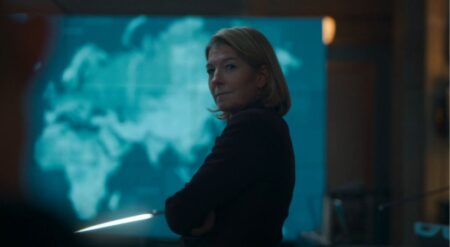
“The Companion” left me asking why all bullies are named Billy? In this vignette, a young boy named Harold (Logan Allen) is bullied by his older brother Billy. Trying to escape him, Harold sneaks into an abandoned farm that is protected by a supernatural force. With a story from Joe R. Lansdale, Kasey Lansdale & Keith Lansdale, and adapted for Creepshow by Matt Venne, this supernatural hide and seek is one that keeps you bought in. Directed by Dave Bruckner, we watch Harold run, hide, and discover the mystery behind the guarded farm.
With a Frankenstein component, this story goes deep into loneliness and how it influences our behavior. While the practical effects are adorable in a campy way, it’s also creepy. As a creature feature, “The Companion” works undeniably well. The atmosphere and creature design fits the tone of the series as it morphs into a story of revenge. That being said, this revenge pivot is one that comes out of nowhere and shifts “The Companion” into more of a kid’s power fantasy and less of a story of loneliness, making the second act feel disconnected from the whole.
In the other vignette in Creepshow Episode 4, “Lydia Layne’s Better Half,” we see self-made woman Lydia (Tricia Helfer) pass up her protégée and lover Cee but fail to anticipate the fallout from her choice. With a story from John Harrison & Greg Nicotero, adapted by John Harrison and directed by one of my favorite directors, Roxanne Benjamin, we see the ramifications of selfish choices.
In “Lydia Layne’s Better Half” we see the stereotypical powerful woman who preaches female empowerment at conferences but ignores her own actions so long as it means that she can remain powerful and happy. Instead of advancing Cee (Danielle Lyn), she resigns her to a life as the partner of a successful woman instead of allowing her to rise on her own.
This vignette works on many levels, exploring relationship dynamics that we often see between men and women by instead putting it between two women. It would be easy to put this story in a pile that tries to show that women too are capable of cruelty and just that. Instead, watching the film as a brown woman, I find myself bringing my experience into the narrative.
Often, the women in charge of women’s movements are not women of color, something that we’re feeling as the older generation of feminists are being told to look at how they have helped keep women of color beneath them. Cee, a woman of color, is relegated to a sidekick, kept below Lydia, for what seems to be love at first but eventually sounds more like fear of losing her own standing. More often than the white women at the top of the pyramid-like Lydia neglect those around them that push the status quo in a way that goes against their ideals. When Lydia accidentally kills Cee, getting stuck in an elevator with the body, the guilt and the consequences of her actions become clear really quickly.

We see this with prominent women in the Democratic party refusing to support “The Squad,” a group of four congresswomen elected in the 2018 United States House of Representatives elections, made up of Alexandria Ocasio-Cortez, Ilhan Omar, Ayanna Pressley, and Rashida Tlaib. While other women in the party are championed, these women, more often than not, are chided for not playing into respectability or “civility.” This is something also experienced by senior congresswoman Maxine Waters.
While at its core “Lydia Layne’s Better Half” is about dealing with the guilt of falling to jealousy, the theme below the surface is clear to me as a viewer. It is especially evident as Lydia becomes more unstable and begins screaming at Cee while trapped in an elevator reasserting her position as “Woman of the Year.”
Additionally, Benjamin was the perfect director to bring this story to life. Having just completed Body at Brighton Rock earlier this year, a film centered on a park ranger who discovers a dead body after becoming lost in the forest, Benjamin is great at framing her shots and building tension in cramped settings. Additionally, Hefler’s performance is wonderful in the third act of the vignette. It’s panicked and unhinged. Accented by somebody’s effects, “Lydia Layne’s Better Half” is a solid addition to the Creepshow family of stories.
Overall, Creepshow Episode 4 is well-crafted, even if the opening story, “The Companion” falls into the same camp as last episode’s “All Hallows Eve.” Both of those vignettes are perfect for Are You Afraid of the Dark? and less so for Creepshow. Just like last week, when paired with “Lydia Layne’s Better Half,” that lands on the more adult end of the spectrum insofar as theme, “The Companion” falls short. Had it been paired with last week’s opener, it may have felt more cohesive. That said Creepshow remains a must-watch.
Creepshow, Episode 4 - "The Companion/Lydia Layne's Better Half"
-
Rating - 7/107/10
TL;DR
Overall, episode four of Shudder’s new original is well-crafted, even if the opening story, “The Companion” falls into the same camp as last episode’s “All Hallows Eve.” Both of those vignettes are perfect for Are You Afraid of the Dark? and less so for Creepshow. Just like last week, when paired with “Lydia Layne’s Better Half,” that lands on the more adult end of the spectrum insofar as theme, “The Companion” falls short. Had it been paired with last week’s opener, it may have felt more cohesive. That said Creepshow remains a must-watch.








